| Author |
Message |
    
andrew
Moderator
Username: andrew
Post Number: 1112
Registered: 11-2001

| | Posted on Tuesday, March 29, 2005 - 06:17 pm: | 




|
I received the following from H�l�ne Chevarie.
I hope she can preserve that engine, it would be a valuable part of local history...
quote:Hi,
I found your web site and was very interested to know more information about antique atlantic motor industry. I just bought the Old marine engine Third edition.
I live on a small fishermen's village in Magdalen'islands (excuse my bad english) and I try to know more about a gasoline-powered hauler that is very old in our localty and try to save it before that some metal fan want to stole it. I join you some pictures. All what I can see that is writen is the name Acadia on a pedale. I show you also a picture taken before that the winch as been touch by someone. I have more photo if you need to identifiy the kind of engine.
Thank you very much to accept to help me if you can!
H�l�ne Chevarie
La Maison du H�ron
21, ch. Quai sud, Pointe-aux-Loups
Iles-de-la-Madeleine, G4T 8B3
Site web: www.la-maison-du-heron.com
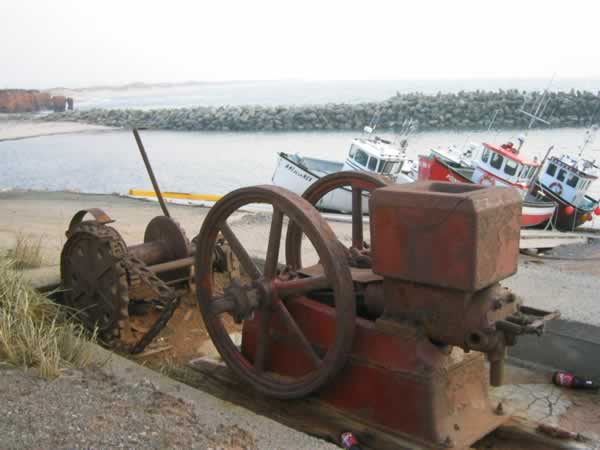
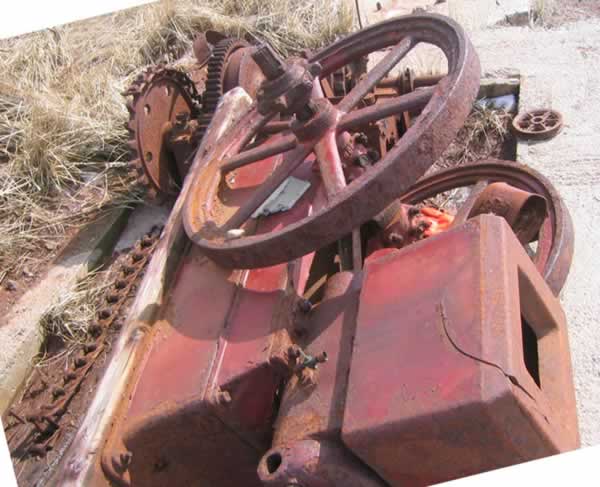
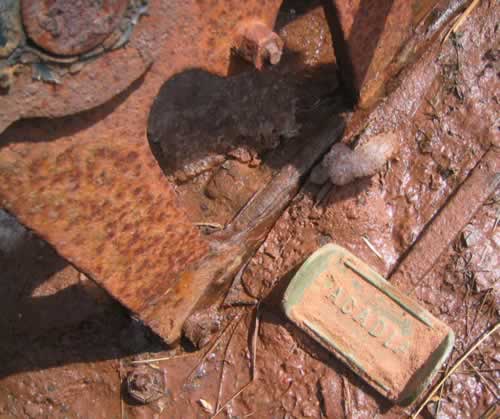 |
    
andrew
Moderator
Username: andrew
Post Number: 1113
Registered: 11-2001

| | Posted on Tuesday, March 29, 2005 - 06:26 pm: | 




|
H�l�ne,
That engine and winch was likely made by Acadia Gas Engines, LTD. in Nova Scotia, Canada. There will be quite a lot of information about the company in the book you ordered.
That engine an winch probably served as power for a "marine railway" to pull boats out of the water.
It would certainly be worth preservering, either to be restored or at least prevented from further decay. Is there a local historical society that you could enlist?
I have various catalog information on the engine if you need it.
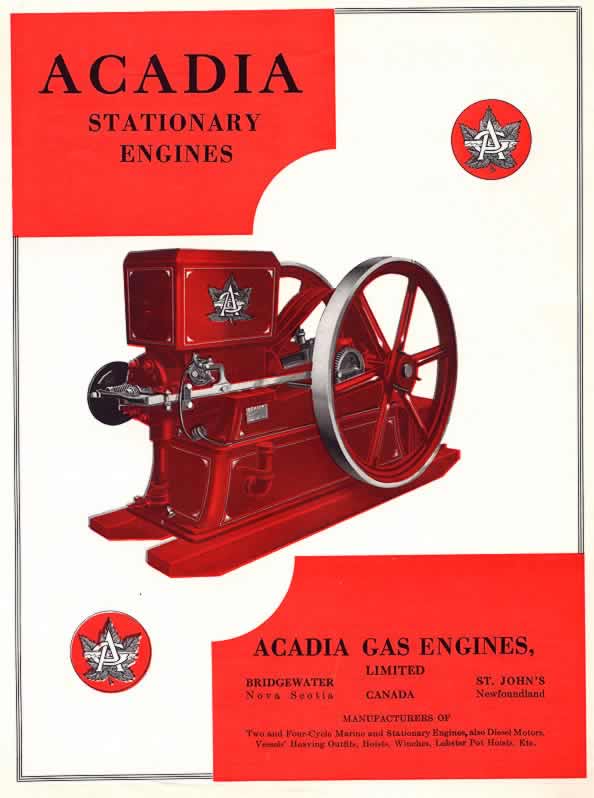
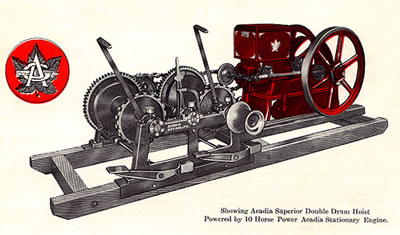
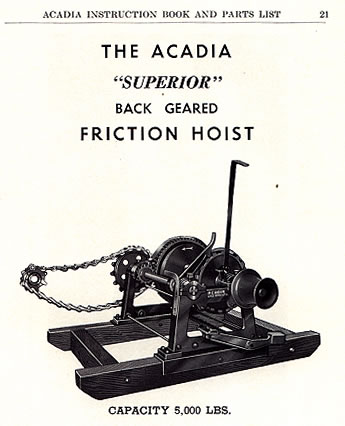
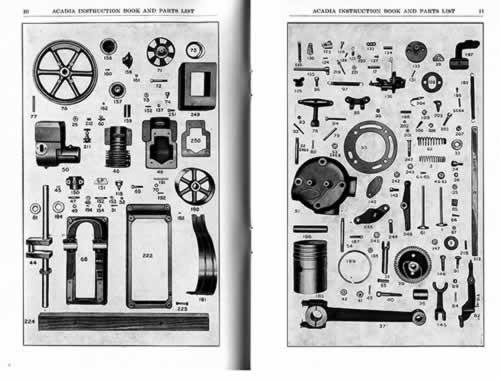 |
    
Helene Chevarie
Visitor
| | Posted on Tuesday, March 29, 2005 - 11:09 pm: | 




|
I'm happy to see the last picture with parts because one round piece was near of the engine and I wasn't sure if it was a part. I will save it with the others small parts that i will find!
I'm actually in discussion with someone from municipality to find a way to preserve this part of our local story. But, in my opinion, it's the fist time that someone try to restore this kind of machine in Magadalen's. We will need a lot of help and documentation. For sure, i'm interested to buy more catalogue or book about the construction and photos of this engine. And, if some other antique motor enthusiasts have picture of the same machine in good condition or any kind of information, please, send it on the forum! |
    
robert
Senior Member
Username: robert
Post Number: 156
Registered: 07-2003
| | Posted on Wednesday, March 30, 2005 - 12:40 am: | 




|
I would remove the engine from its exposed location 'vitement', before someone else does. Surely someone locally must know the history of the engine? Good luck with it. This could be the start of a local museum, if you do not have one already? |
    
Helene Chevarie
Visitor
| | Posted on Wednesday, March 30, 2005 - 12:52 pm: | 




|
I need to know how much pounds have this machine, if we want to remove it. I can't move it a little.
We have a museum on the other point of the islands but I'd like this engine stay definitively near of the wharf to make a kind of interpretative centre.
May be we should put a kind of window "dome" around to preserve it when it will be restored ! I really don't know. The small fisherman house that was there before, has been destroyed with the years and disapeared about 4 years ago. |
    
andrew
Moderator
Username: andrew
Post Number: 1114
Registered: 11-2001

| | Posted on Wednesday, March 30, 2005 - 01:27 pm: | 




|
Helene,
I have specs on the stationary model engine like that one, but I don't know exactly what "size" yours is.
I would "guess" that yours is the 6HP model. You could confirm this by measuring the diamater of the flywheel (the two large spoked wheels on the engine). The 6HP should have a 27" diameter flywheel. If so the weight is 800 pounds.
If it is larger it would be the 10HP, 36" diam flywheel, 1550 pounds.
If it is smaller it would be 4HP, 23" diam flywheel, 570 pounds.
It would not be hard to move with the right equipment. |
    
Helene Chevarie
Visitor
| | Posted on Wednesday, March 30, 2005 - 09:25 pm: | 




|
I will check the size tomorrow, when it will be less windy! |
    
Helene Chevarie
Visitor
| | Posted on Thursday, March 31, 2005 - 05:57 pm: | 




|
I checked this afternoon the size of the biggest wheel. It's 36"! So it's a 10HP.
My father told me that he always see that machine since he's born in 1932. His father had a wood factory (to cut wood) that use this kind of stationary engine, but the mark was "fairbank". I don't know if it's the good spelling. |
    
andrew
Moderator
Username: andrew
Post Number: 1116
Registered: 11-2001

| | Posted on Thursday, March 31, 2005 - 06:11 pm: | 




|
Great!
10HP is a big engine. 1550 pounds is heavy but still managable. Talk to some of the locals that have equipment suitable such as a small mobile crane or a tilt bed truck. Be careful not to let them pick it up by the flywheels or you risk the possiblity of bending the flywheels or the crankshaft.
The engine your father used was probably a "Fairbanks-Morse". There were a very popular farm and stationary engine made in many sizes and styles.
Acadia was primarily a marine engine manufacturer, but also made some stationary engines such as this one.
Keep us posted! |
    
Helene Chevarie
Visitor
| | Posted on Thursday, March 31, 2005 - 10:43 pm: | 




|
Your instruction about the moving of the engine are really usefull! It's the kind of things that we forget to think about. As soon as possible, I will take the smaller parts that I can move now to keep it out of the bad weather and thiefs.
I want to know for the electrolyse technique. Can we use a kind of ciment bath to put the engine inside? There is a building near of here that have this. |
    
Helene Chevarie
Visitor
| | Posted on Thursday, March 31, 2005 - 10:47 pm: | 




|
I forgot to ask you... is it possible for a couple of bad boys to move a 1550 pounds machine like that? Or it's possibly someone that wanted to move it with a cable on his truck? I need to know who have interest to do that. |
    
richardday
Senior Member
Username: richardday
Post Number: 380
Registered: 11-2003

| | Posted on Friday, April 01, 2005 - 05:00 pm: | 




|
Andrew somewhere I read who licensed the engine for Acadia to manufacture. It was not an Acadia designed engine. I expect the hoist was Acadia designed but not the engine. That engine in various sizes was all over the Hudson Bay and Newfoundland, Labradore area. It was used typically for boat railways and cordwood saws from what I have heard. |
    
andrew
Moderator
Username: andrew
Post Number: 1118
Registered: 11-2001

| | Posted on Friday, April 01, 2005 - 05:55 pm: | 




|
Dick,
That makes sense.
Does anyone know who would have manufactured that engine for Acadia? |
    
andrew
Moderator
Username: andrew
Post Number: 1119
Registered: 11-2001

| | Posted on Friday, April 01, 2005 - 05:57 pm: | 




|
Helene,
That engine would be too large for two people to move... no mater how "bad" they are...
Disassembling it on site is a possible option, but there are other potential hazards in doing that.
You really need some help from someone experienced with machinery. You might need to ask locally at a machine shop, fabrication shop, heavy equipment repair shop, etc. Also maybe you can post your location here (and what is nearby) in case anyone viewing this discussion might offer to help, or can give you suggestions for someone nearby that might help. |
    
larry_from_maryland
Senior Member
Username: larry_from_maryland
Post Number: 219
Registered: 07-2003
| | Posted on Friday, April 01, 2005 - 07:20 pm: | 




|
On harry's old engine site a person says that the acadia is a copy of the united engine made by associated manufacturers. |
    
richardday
Senior Member
Username: richardday
Post Number: 381
Registered: 11-2003

| | Posted on Friday, April 01, 2005 - 07:37 pm: | 




|
Yes thats what I remember now. You are right Larry. I think it is one of Stan Grayson's books as well. They were actually made by Acadia in Bridgewater, NS |
    
Philip Spencer
Visitor
| | Posted on Sunday, April 03, 2005 - 05:28 pm: | 




|
I agree with the "United" connection with Acadia and I had mentioned that to Helene in my original private email. Also to Helene; a cement bath or tub would be quite suiable to perform electrolysis. But it would be best to take the engine apart to the smallest possible parts and clean them separately otherwise you would need a great deal of energy (i.e. many car batteries or a very strong battery charger). For those unfamiliar with electrolysis, see http://users.eastlink.ca/~pspencer/nsaeta/electrolysis.html
Nova Scotia Antique Engine & Tractor Association |
    
Helene Chevarie
Visitor
| | Posted on Wednesday, April 06, 2005 - 11:11 pm: | 




|
Someone told me that it's also possible to use sandblasting to clean the parts. I suppose that it's not a good idea?
As the parts are all sticked together with rust, it will be hard to move it in small parts, i guess... |
    
peterogborne
Senior Member
Username: peterogborne
Post Number: 241
Registered: 09-2002
| | Posted on Thursday, April 07, 2005 - 07:50 am: | 




|
Good luck with your venture Helene. It is great to hear someone with so much enthusium. Hope it all works out.
Just a question ...where is Magdelene Island? |
    
andrew
Moderator
Username: andrew
Post Number: 1125
Registered: 11-2001

| | Posted on Thursday, April 07, 2005 - 09:14 am: | 




|
Thanks for asking Peter, I have been wondering too...
Helene, you can sandblast parts, but you have to be careful. There are many methods and materials for sandblasting, and there is potential for damaging parts if is not done properly (especially the small parts).
In addition to the electrolysis method linked above, you can also remove rust in a molasses bath. Use the search link at the top of this page and search molasses. You will see numerous discussions and links describing the process. |
    
adriaticsun
Member
Username: adriaticsun
Post Number: 4
Registered: 03-2003
| | Posted on Thursday, April 07, 2005 - 10:54 am: | 




|
Magdelene ilands are just ENE of Prince Edward Iland in the gulf of ST. Lawrence CANADA...... |
    
adriaticsun
Member
Username: adriaticsun
Post Number: 5
Registered: 03-2003
| | Posted on Thursday, April 07, 2005 - 10:57 am: | 




|
I'm sorry I ment WNW....... |
    
Helene Chevarie
Visitor
| | Posted on Thursday, April 07, 2005 - 11:48 am: | 




|
Andrew, you can be sure that the molasse afraid me less than the eletrolyse technic! Probably because I use it more often!
I never known where come from all the persons that use this forum. I guessed that it was probably people from Nova Scotia, am I right?
Here is a link for Magdalen's islands information: http://www.tourismeilesdelamadeleine.com/contenu/index_ang.cfm |
    
helene
New member
Username: helene
Post Number: 1
Registered: 04-2005
| | Posted on Thursday, April 07, 2005 - 12:07 pm: | 




|
I discovered the profil utility just now! I decided to open one. |
    
peterogborne
Senior Member
Username: peterogborne
Post Number: 242
Registered: 09-2002
| | Posted on Friday, April 08, 2005 - 07:55 am: | 




|
What coincedence Andrew. As you know i live in the coastal town of Albany right down the bottom [south] of West Australia .We are on the Great Southern Ocean . I had a phone call this evening from a person who originally hails from California ,19 years ago . He has a vineyard and i suggested i visit him at the Porungurups and have a sample. Any way he is building a ,as he described it a vintage wooden boat and he asked me if i had any info on a suitable winch ,something that would fit the style of boat . When he gives me some more information i will put a request on OME. Coincedince ...the winch ! |
    
andrew
Moderator
Username: andrew
Post Number: 1126
Registered: 11-2001

| | Posted on Friday, April 08, 2005 - 12:51 pm: | 




|
Peter,
That is a coincidence. I wonder what he will use the winch for?
Helene,
The majority of visitors to this site are from the United States. There are also a lot from Canada, Australia, New Zealand, UK, and throughout Europe.
The mollasses is certainly a friendlier method. I have'nt tried it but as you see from the other posts many people have had good success with it.
Keep us posted. |
    
Michael Mason
Visitor
| | Posted on Monday, April 18, 2005 - 11:47 pm: | 




|
Interesting reading, folks. I grew up two blocks from the Acadia Gas Engines factory in Bridgewater. When I was about ten years old I used to deliver a weekly newspaper to the manager's office and to the Chief Draftsman. Back in those days (middle 'sixties) there was not so much concern about liability and such, so an inquisitive kid could wander through the plant pretty much unimpeded, 'cept for when they were pouring steel in the foundry - too many hot sparks for someone without protective clothing. But I used to be right in there "helping" to pack sand and shake out moulds when they were pouring bronze or cast iron. I was fascinated by the fact that grown men could spend all day playing in sand. The machine shops were pretty cool, too.
Too bad I didn't have the presence of mind to take my camera with me - all the images I have of the place are between my ears, and the media is fading.
All the buildings except one are gone now. The building across the road from the waterfront that used to house the assembled engines storage (basement), assembly & shipping (first floor), and pattern-makers shops and drafting offices(second floor) has been remodelled into condominium apartments. The rest of the site - main office, machine shops, fabrication shop, generator plant, foundry, and stamping mill have all been torn down and the site has been turned into a riverside park. |
    
andrew
Moderator
Username: andrew
Post Number: 1133
Registered: 11-2001

| | Posted on Tuesday, April 19, 2005 - 08:49 am: | 




|
Michael,
Thanks for the "first hand" historical account of the factory! That's terrific! |


